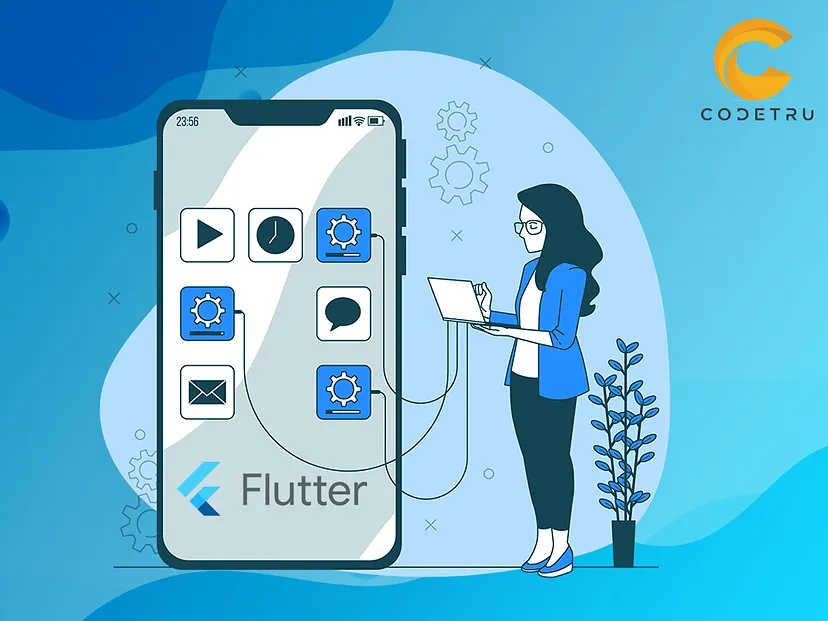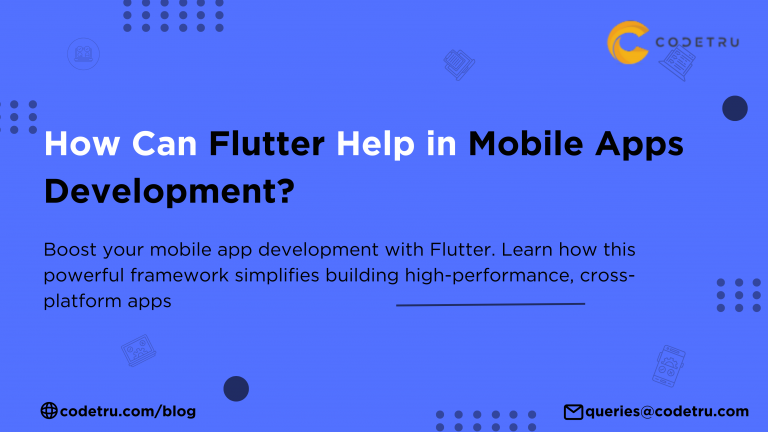Before we take a deep dive and see how Flutter works for mobile apps development, let’s first understand what Flutter is?
What is Flutter?
For starters, Flutter is not a framework, nor a software language. It is a completely free, open-source software development kit (SDK) developed by Google for creating mobile, desktop, embedded devices, and web applications via a single codebase for iOS and Android platforms. It comprises a collection of libraries, frameworks, widgets, APIs, documentation, and tools with which the developers can easily build beautiful interfaces.
Flutter can help the developers create unique app designs all by themselves with its built-in UI elements. When it comes to its popularity, Flutter has crossed React Native, a commonly used JavaScript framework for creating native apps.
Flutter is built using a fast, object-oriented programming language called Dart. Flutter offers easy app development with lesser start-up time and better performance due to Dart’s ability to directly compile into native code without the help of JavaScript irrespective of the platforms.
Automated Testing using Flutter
Flutter comes with an automated testing toolset for performing the unit test, widget test, and integration test. Google’s documentation is readily available to perform these tests. Flutter enables debugging through Flutter DevTools which help in checking the layout, analyzing the performance, and debugging the app.
Advantages of leveraging Flutter for mobile apps development
Flutter helps in creating innovative, unique, progressive web apps, extending mobile apps to the web, and building desktop applications. So, what are those features that make Flutter the developers’ first choice over the other traditional tools for mobile application development? Let’s see.

Easy to learn — People with limited programming knowledge are seen building amazing apps using Flutter, thanks to the well-structured documentation offered by Google. Apart from that, Google offers video-based training and practical exercises on Codelabs for amateur developers.
Faster App development — Flutter enables quicker native interface development within minutes with the help of rich customizable widgets and its Hot Reload feature. Building fully customizable UIs with quick debugging and rapid rendering of changes are a few of its takeaways.
Write once, deploy in five — With Flutter 2, developers can use single code to deploy in five different platforms — iOS, Android, Windows, macOS, and Linux.
Builds expressive, friendly UIs — Flutter’s layered architecture enables full-fledged customization for building expressive, flexible designs.
Native performance — Flutter’s widgets support all crucial platform differences in terms of scrolling, navigations, fonts, and icons to enable native performance on iOS and Android.
Long-time support by Google — Google offers constant support to Flutter users being a parent company and the biggest user itself. Flutter offers quick and instant debugging and is undergoing rapid improvement constantly for a long overhaul.
Hot Reload tool — The Hot Reloading feature in Flutter is readily available on Flutter for seeing quick updates and easy fixing of errors. Hot Reload feature essentially helps improve the developers’ productivity, offers flexibility in experimenting with different options without much ado.
High performance — It is already established that Flutter offers quicker app development. However, Flutter has proved to be the top performer among its peers including Xamarin and React Native with 58 fps and 220-millisecond launch time.
Portable — With Dart being the base for developing Flutter, it extends its portability and compilation features. It means the same codebase can be used for five different platforms — iOS, Windows, Android, Linux, and macOS.
Internationalized — With other app development technologies, internationalization is a separate process. The apps need distinct code for deployment in different languages specific to various geographical locations which are typically done at a later stage. However, this process is simplified in Flutter with the Dart intl package. It supports 78 languages, various currencies, dates, different measuring units, and diverse layout options especially for languages written from right to left.
Drawbacks of Flutter
Fewer third-party libraries
Third-party packages for app development are quintessential as they reduce the development time relieving the need of developing the code from scratch. However, as compared to Flutter’s closest competitor, React JS, Flutter does not integrate with many third-party libraries. But, not to worry. Flutter’s SDK covers over 15k packages in-house in addition to Flutter’s versatile widgets dismissing the need for third-party tool integration.
App size is bigger
Flutter apps cannot come under 4 MB storage space. Period. While the apps, built using native Java, Kotlin use around 550 KB, Flutter’s minimum app size is almost four times their size. Developers fight tooth and nail to bring down the app size as mobiles have less storage space and the users will have to delete their other favorite apps in favor of installing the apps built on Flutter.
Dart is a double-edged sword
Dart has many advantages including being fast, simple, and object-oriented. However, when it comes to choosing between JavaScript, Java, C#, and Dart, the latter loses in competition. Hence, finding Dart developers can be a problem for any mobile application development company as compared to the other programming language experts.
Is Flutter always a preferred choice?
Flutter might have beat the traditional app development technologies in terms of speed and ease, but the fact remains that Flutter is still in the nascent stage to be the most preferred technology. However, rigorous advancement is underway with its potential to emerge as an outstanding technology, imperative. So, when Flutter might not be a top choice…
When building progressive web apps and instant apps are on the cards.
To build apps that require communication with any hardware through Bluetooth.
Usage of rare, native libraries which do not integrate with Flutter.
Who is using Flutter?
Tech giants like Google, Alibaba, eBay, BMW, Capital One, and many more companies use Flutter to develop beautiful apps in record time.
FAQs on How Can Flutter Help in Mobile Apps Development
1. What is Flutter and why use it for mobile app development?
Flutter is an open-source SDK by Google for creating native interfaces on iOS and Android using a single codebase. It offers fast development, high performance, and supports multiple platforms like iOS, Android, Windows, macOS, and Linux.
2. What are the advantages of using Flutter for app development?
Flutter enables rapid app development with features like Hot Reload for quick updates, expressive UIs with customizable widgets, and native performance on both iOS and Android. It supports internationalization, offers strong support from Google, and allows deployment with minimal platform-specific code.
3. How does Flutter compare to other frameworks like React Native?
Flutter surpasses competitors with its performance metrics, including high FPS rates and quick launch times. It boasts a unified codebase for multiple platforms and integrates seamlessly with Dart, its optimized programming language.
4. What are the drawbacks of using Flutter for mobile apps?
Despite its strengths, Flutter faces challenges such as a larger app size compared to native solutions and fewer third-party libraries. Dart’s adoption rate among developers is another consideration for teams transitioning to Flutter.
5. Is Flutter suitable for all types of mobile app development?
While Flutter excels in most scenarios, it may not be ideal for apps requiring deep hardware integrations, rare native library support, or extremely small app sizes. Evaluating project requirements against Flutter’s capabilities is crucial for determining suitability.







